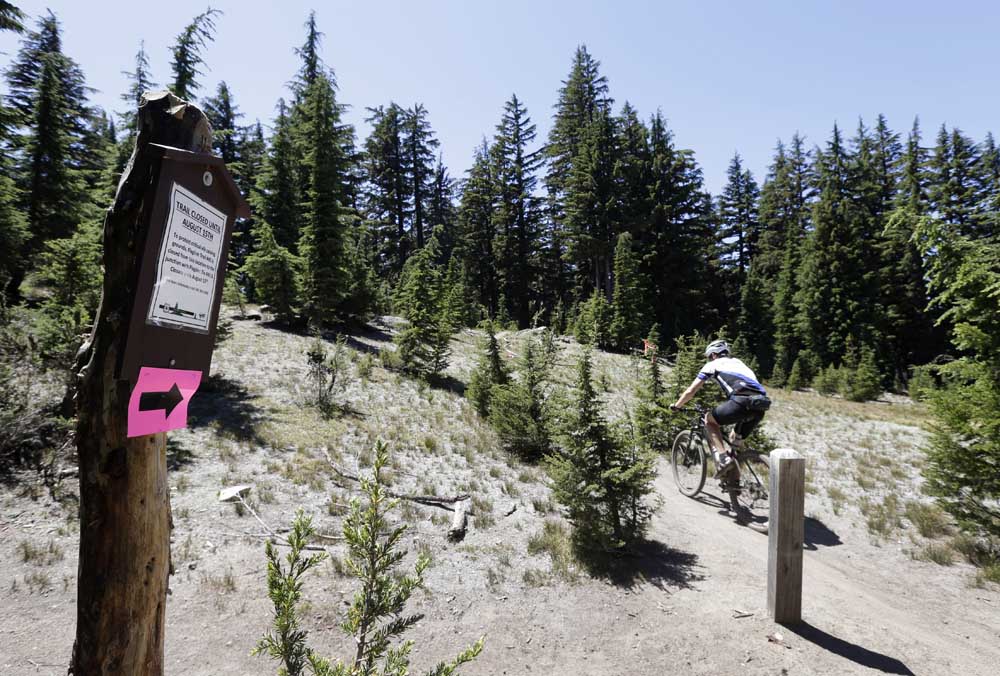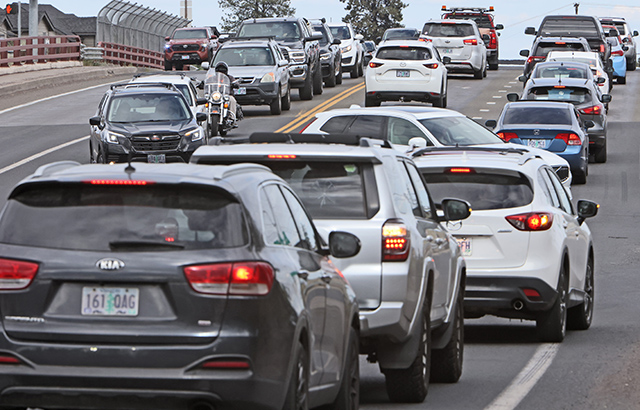Elk, cyclists in conflict on mountain trail
Published 12:00 am Thursday, July 19, 2018

- A trail closure sign for the Middle Flagline Trail is visible as a mountain biker rides past the intersection on the Flagline Access Trail west of Bend in this file photo. Log out work has begin on Flagline after being closed till Aug. 15 for elk calving protection.
Signs along a 4-mile stretch of mountain bike trail deep in the Deschutes National Forest warn cyclists not to use it until Aug. 15, as a way to protect elk in the area while they give birth.
However, wildlife biologists and environmentalists are concerned that a few mountain bikers are still using the area, colloquially known as Middle Flagline Trail, despite the signs.
Trending
They warn that this illicit use pushes elk out of a key part of their habitat and contributes to a larger pattern of overuse of the forest.
“As we get more and more people in the area, we have to keep telling the same story over and over,” said Nicole Strong, assistant professor at Oregon State University’s forestry and natural resources extension service.
While it’s likely that only a handful of mountain bikers are using the trail during the closure, Erik Fernandez, wilderness program manager for Oregon Wild, said the problems with illegal use aren’t new.
In 2016, Strong and Brock McCormick, a wilderness biologist with the U.S. Forest Service, wrote a blog post for BendTrails.com, warning cyclists that using the stretch of trail during the closure can force the animals to move to less optimal territory, which can hurt their chances of survival.
A sign put up by the Forest Service to warn cyclists not to use the area was knocked down last summer, and was not immediately replaced, Fernandez said.
This year, the sign has stayed intact, but Fernandez said he’s seen cyclists using the trail on trail cameras, as well as on social media.
Trending
“If you have even a few mountain bikers coming through per day, that has a big impact,” Fernandez said.
Flagline Trail, located north of the Cascade Lakes Highway near Tumalo Mountain, is a relatively popular spot for mountain bikers looking for a more rugged experience once the snow melts at higher elevation, according to Bruce Schroeder, chair of the Central Oregon Trail Alliance’s board of directors. Schroeder added that the trail lacks dramatic views, but has significant elevation gains that make it popular with backcountry mountain bikers.
It also happens to be near favorable habitat for elk living in that part of the forest. Unlike deer, elk populations have slowly grown in that portion of the forest to an estimated 700 elk, according to Corey Heath, wildlife biologist for the Deschutes district of the Oregon Department of Fish and Wildlife.
Heath said elk prefer high-elevation areas that have easy access to water, grazing and protective cover from predators — what wildlife experts call “core habitat.” Bill Littlefield, board member of the Oregon Hunters Association’s Bend chapter, added that elk tend to cycle through areas of their core habitat, rarely spending two days in a row in one area.
The problems arise when humans come too near. Littlefield said elk are very skittish around people, and even small disturbances can cause them to flee their core habitat, into areas that may have less cover and less food.
“In their mind, they’re deeming that the lesser of two evils,” Heath said.
Unlike deer, elk often don’t return to the areas they vacate, which has the potential to put them in dangerous situations where they have a higher risk of being killed by predators like cougars, bears or humans, Heath said.
These problems are exacerbated during calving season. Littlefield said mothers can get separated from their calves when they disperse, leaving the calves stranded and vulnerable.
Mountain bikers impact elk more than hikers, Littlefield said. While backcountry hikers make noise when crashing through undergrowth, mountain bikes are relatively quiet, allowing them to sneak up on animals more easily, he said. Consequently, elk tend to stay farther away from bikes than hikers or horseback riders, based on research conducted in the Starkey Experimental Forest and Range in Northeast Oregon.
“A mountain bike looks a lot like a predator to them,” Littlefield said.
While Schroeder said he has not personally seen cyclists using the trail inappropriately, he acknowledged that a few rogue riders may be riding there. On high-elevation trails, snow often doesn’t melt until June, and returns by the end of September, creating a much smaller window for cyclists to use them, Schroeder said. He added that a few riders likely want to beat the rush by using the trail when it’s closed.
“It’s a short window to ride, so once it’s open legally, a lot of people are up there,” Schroeder said.
Fernandez added that Central Oregon’s population growth plays a factor as well. More people mean more mountain bikers, he said. As with other parts of the Deschutes National Forest, Flagline Trail has seen more use throughout the summer in recent years, which puts more pressure on a variety of species living in the area. He said he’d like to see the Forest Service enforce its closures better, and to strike more of a balance between recreation and the environmental impacts that come with it.
Schroeder added that Central Oregon Trail Alliance tries to educate the public about trail etiquette. He added that the Forest Service could close Flagline Trail entirely, unless riders behave better.
“People who don’t, put us at risk of losing the trail forever,” he said.
—Reporter: 541-617-7818, shamway@bendbulletin.com








